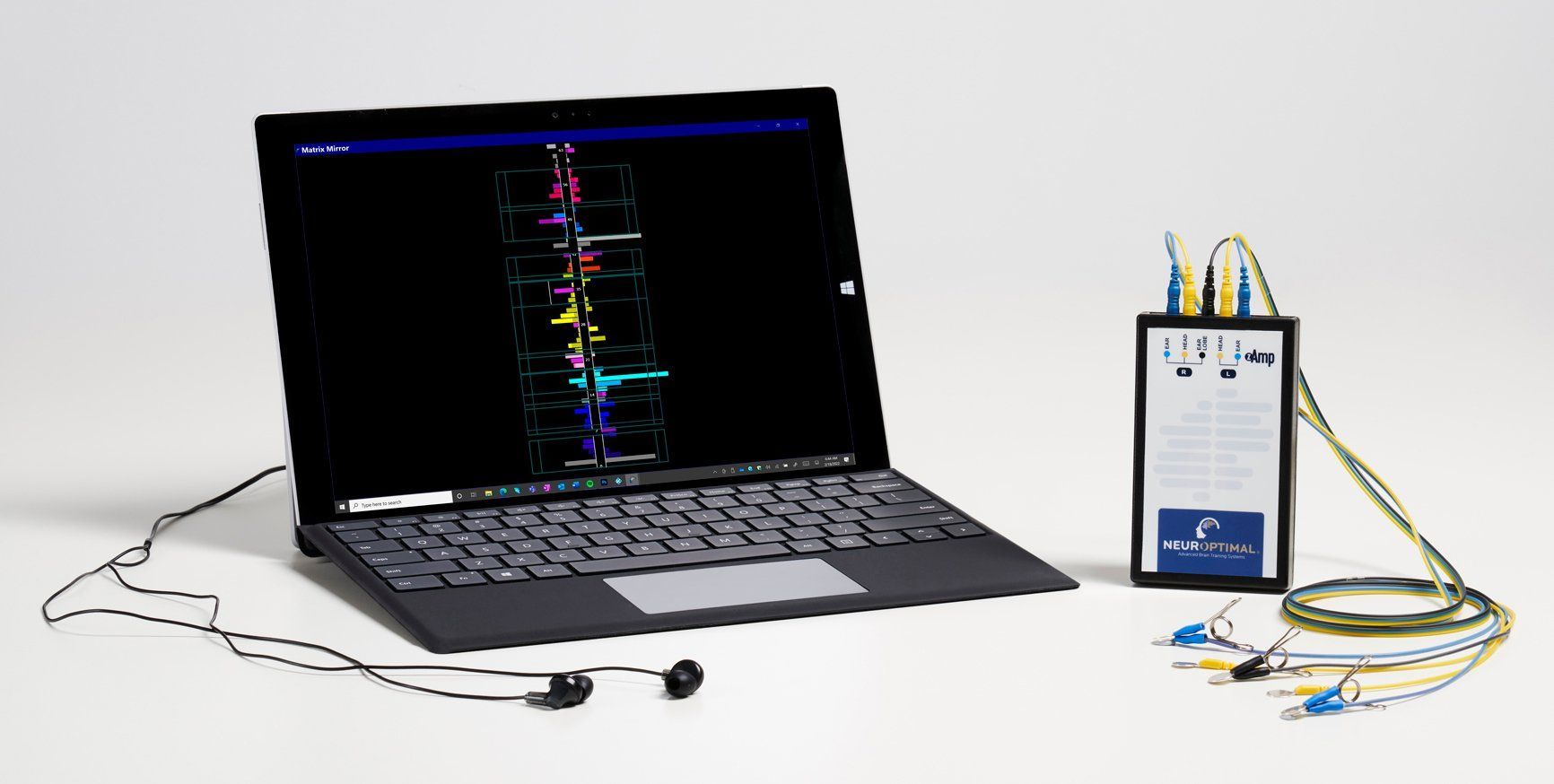Neurofeedback in Brisbane
Neurofeedback in Brisbane
Neurofeedback Brain Training in Brisbane, is offered for children, teens and adults. Neurofeedback can assist with symptoms such as sleep issues, emotional regulation, memory issues, focus and attention, and trauma re-experiencing symptoms.
We offer a Neurofeedback Device Rental Program, for clients to access Neurofeedback in Brisbane and throughout Australia.
How Neurofeedback Can Help:
Sometimes the Brain does not function as well as it is able to, and this is called a dysregulated brain. What this means is that when you are supposed to be calm, you can instead tend to feel over-stimulated, and when you are supposed to be alert, you can instead tend to feel under-stimulated.
Sometimes, the brain can naturally correct itself, and sometimes it doesn’t and requires some form of assistance, with traditional methods including medication. What is actually happening in the brain when the brain doesn’t naturally correct itself, is where dysregulation becomes the “new normal” for the person. So what Neurofeedback does is it helps the brain to retrain itself to its natural regulated state.
Why Use NeurOptimal® Neurofeedback?
NeurOptimal® Neurofeedback is an advanced, non-invasive method that helps optimise brain activity. By training your brain to self-regulate, it can lead to improvements in a variety of cognitive and emotional areas.
Here are some typical presentations of why people would seek out neurofeedback:
Stress and Anxiety Management
Many individuals use neurofeedback to reduce stress and manage anxiety. Neurofeedback helps to regulate the nervous system, leading to a calmer, more focused state (Hammond, 2011).
Improvement in Sleep Quality
Neurofeedback has been shown to improve sleep quality and help individuals with insomnia by training the brain to settle into more restful sleep patterns (Hossain et al., 2015).
Attention and Focus Issues
For those with Attention Deficit Hyperactivity Disorder (ADHD) or attention-related challenges, neurofeedback can help improve concentration and attention span by optimising brain wave patterns (Cohen, 2014).
Mood Regulation
Neurofeedback can assist in managing mood disorders, including depression and emotional instability, by promoting a more balanced brain activity (Hammond, 2011).
Trauma and PTSD
Individuals recovering from trauma or dealing with PTSD can use neurofeedback to re-regulate brain waves, reducing hyperarousal and improving emotional stability (Peniston & Kulkosky, 1991).
Cognitive Enhancement
For individuals looking to enhance cognitive function, neurofeedback helps improve memory, problem-solving abilities, and overall cognitive performance (Muentener & Ros, 2015).
What is Neurofeedback?
Neurofeedback, also known as Neurotherapy, Neurobiofeedback and EEG biofeedback, is an advanced type of brain-based therapy, which is non-invasive form of positive brain training. Neurofeedback utilises real-time displays of brain activity through the use of electroencephalography (EEG), to teach self-regulation of brain function. It detects inconsistency and abrupt changes in the electrical activity of your brain that undermine optional functioning and informs the brain of these sudden shifts through interruptions in the sound you are listening to. This refocuses your brain's attention to the present moment and allows your brain activity to naturally self-correct. This process of change is called neuroplasticity, which allows for us to make changes in attitudes, beliefs, emotional states and behaviour.
Your brain is capable of optimal functioning, but when your central nervous system is off kilter your brain can operate inefficiently. Neuroptimal is a
non-linear dynamical neurofeedback brain training program to work with the natural brain's capacity for change, and train the brain to work at optimal performance. This means that a brain scan is not required before you start training, and the changes achieved are instantaneous. Over time, our cognitions can become weakened, and neurofeedback can re-route thought patterns, break emotional habits and help restore healthy mental processes. It gives feedback directly to your brain, allowing it to regulate itself more efficiently which
improves mental functioning, enhances your mood and builds resilience.
Developed by Psychologists, for Psychologists

The specific technology which we offer is called NeurOptimal® Neurofeedback which is an advanced neurofeedback technology used to train the brain to function optimally. Designed by clinical psychologists Dr Valdeane Brown and Dr Sue Brown, it utilises the world’s only non-linear Dynamical Neurofeedback process to communicate directly with the central nervous system. This innovative form of neurofeedback exclusive to NeurOptimal® gives the brain the information it needs to help reorganise itself.
An organised brain tends to be calmer, clearer, and more open to learning. Everyday problems seem to fade away, and you are given the opportunity to function better in life.
Why would I use Neurofeedback Brain Training?
Many people use brain training systems to help sharpen or maintain their mental abilities. As we grow older certain mental faculties like our short-term memory retention, processing speed, planning skills, decision-making, and reaction time tend to deteriorate. Some of the ways to counteract this are to keep the mind active.
Neurofeedback Brain Training helps improve focus, emotional regulation, and mental clarity by teaching your brain to function more efficiently. It’s non-invasive and tailored to your unique brain patterns, making it especially helpful for managing symptoms of anxiety, ADHD, and stress-related symptoms over time.
How Does the Brain Regulate Itself?
With Neurofeedback, the brain starts to very slowly and very safely learn to engage in a new way as the neurofeedback teaches it to self-regulate.
The electrical activity in the brain is detected by placing a small number of electrodes on the scalp. A tiny amount of conductive paste is placed on each electrode which enables them to stay in place and allows for detection of electrical signals. The electricity generated by the Central Nervous System (CNS) processing can be detected and displayed on a monitor in real time. This system is called an Electroencephalograph or EEG. Using the latest innovation and evidence based technological advances in Neurofeedback, the specifically designed computer software allows for information about the performance and behaviour of the brain and the CNS to be provided to the client via auditory perception interruptions, which sound like glitches in the music to which you are listening to.
Neurofeedback works through auditory perception interruptions that guide the central nervous system back to a regulated state. It is therefore generally considered a nice, relaxing and enjoyable experience.
What to Expect During a Neurofeedback Session
When you rent the NeurOptimal® Neurofeedback Device, you’ll have access to a professional-grade tool designed to work with your brain's natural processes. Here's what you can expect:

Session Duration and Frequency
Sessions typically last about 30 minutes, and it is recommended to have multiple sessions over a period of time for optimal results. Most users start with 2-3 sessions per week, with adjustments based on individual needs.

No Need for Active Effort
Unlike other forms of therapy, neurofeedback doesn’t require active participation from the user. You’ll simply relax in a comfortable chair with sensors placed on your scalp. The device measures your brain’s electrical activity and provides feedback that guides your brain into a more balanced state.

Gentle Feedback Process
The feedback process involves subtle changes in sound or visuals, alerting the brain when it’s functioning in a desired state. This allows your brain to learn to maintain this state on its own, resulting in improved cognitive and emotional well-being over time.

Expect Gradual Improvement
While some individuals report feeling an improvement after just one session, it’s common for the process to take several sessions to see significant changes. Over time, you may notice improved mood, focus, and emotional regulation, along with a reduction in stress and anxiety levels.
What Happens in a Neurofeedback Session?
Once you have hooked up to the EEG system as per the video instructions provided, you will listen to some nice relaxation music. As you listen to the music, you will hear little interruptions or glitches (similar to static), and this is the brain-generated feedback at work. The interruptions are not pre-set in the music. Instead, they are live feedback from your own brainwave activity, which are detected via the EEG system. Every time you hear a glitch in the music, it is training your central nervous system to self-regulate naturally.
How Long Will I Need for My First Neurofeedback Session?
You will need to allow yourself one hour in total for a Neurofeedback session, and during that time you will be listening to music for a little over half an hour. We recommend that you site in a comfortable recliner chair, or a on a couch or on your bed, and with your eyes closed (fi you can). For children, the process is slightly different due to their attention span. Therefore, we recommended low-energy activities for children, such as colouring, sticker books and puzzles, as they sit in the armchair and listen to the audio interruptions in the music. We recommend tailoring such activities to meet your own child's specific needs and own interests.
At the end of the Neurofeedback session, you remove the electrodes. Some people like to take a shower afterward to wash the electrode paste from their hair, but the paste can be easily removed with a baby wipes either.

Is NeurOptimal® Neurofeedback Suitable for Everyone?
NeurOptimal® Neurofeedback is a gentle, non-invasive brain training system designed to be safe and suitable for people of all ages, from children to older adults.
Unlike traditional neurofeedback, it does not require diagnosis or specific targeting of brain areas. Instead, it works with your brain’s natural ability to self-correct by providing real-time feedback when it detects inefficiencies in brain activity.
This makes it ideal for those seeking support with stress, anxiety, sleep, focus, or emotional resilience. Because it doesn’t push the brain in any specific direction, it’s considered very safe, even for sensitive individuals or those with complex conditions.
How Will I Feel After a Neurofeedback Session?
Everyone is different. Some people feel energised, while other people can feel a bit tired. Remember your brain is like a muscle - so it is very much like going to the gym. There are people who feel invigorated by a workout and others who feel exhausted; but both get great benefit. Neurofeedback is like a gym session for the brain. The more you work out, the stronger you get.
What Happens After My First Neurofeedback Session?
There is nothing you need to do as homework, Neurofeedback is a very passive experience - so all you need to do is show up for your next session to build on your last session and reinforce your brain of a new way of self-regulating.

How Many Neurofeedback Sessions Will I need?
Everybody's central nervous system is different, so it is not possible to predict exactly how your brain will respond to the information which the Neurofeedback brain training provides.
On average clients require 10-15 sessions to contain their presenting issue, however many clients report an alleviation from their very first session. As you progress through each session in your program, you will find and discover positive changes along your journey. Neurodevelopmental disorders such as attention deficit disorder (ADD) & attention deficit hyperactivity disorder (ADHD) for example require ongoing regular training for the brain to stabilise and retrain the central nervous system how to respond. After an initial program of neurofeedback training sessions, ongoing sessions may be monthly sessions to help support their presentation.
Based on over three million hours of experience with the specific Neurofeedback system that we offer access to, some predictions can be offered (click here to access). Clinical studies have been conducted on the effectiveness of Neurofeedback across a large variety of presentations, so the good thing is you do not have to take it on faith and trust that it will help you — you will know pretty quickly when it is helping you.
Just as in how long it takes to learn to read, it is a process and everyone learns differently.
How Many Sessions Will It Take to "Complete" a Neurofeedback Brain Training Program?
This depends in consideration of your goals. If you are training to overcome your mental health issues and feel better quickly, you might decide after 10-15 sessions that you have made enough gains and stop.
On the other hand, if you are looking for lasting changes whereby you do not only feel free from your presentation but living a higher functioning and improved quality of life, then 20-30 sessions is a better estimate. Some clients, depending on their presentation, require ongoing monthly sessions. You are always in control and you can stop at any time and always pick it up again later if you so choose.
In short, doing any Neurofeedback brain training is better than doing no Neurofeedback brain training.
Contact Us
Frequently Asked Questions (FAQs)
What will happen if I don't keep up my Neurofeedback sessions?
Any training you have done in the past will always serve you well should you do more sessions in the future — no session is ever wasted.
For some however, training their brain is like training the body. They want to function at their best throughout their lifetime, and they like to maintain that best even when life presents its inevitable day to day knocks and bruises. After a period of initial training they continue with maybe monthly sessions to give their brain a regular opportunity to “defrag”. Or, like many of us, they just do a session when they feel they need it. But in the end, it is always up to you, because it is YOUR brain that is doing the training and it knows what it needs.
How much does a Neurofeedback session cost?
Hire a Neurofeedback device with us from as little as $300 per week. Fees and payment options are available which you can discuss in your Discovery Call (15 mins, by phone, no charge). We encourarge you to make contact with us for an accurate fee quotation.
How do I get started with Neurofeedback Training in Brisbane?
Access Neurofeedback in Brisbane with our Neurofeedback Device Rental Program
Access a home rental system for personal or professional use (minimum 2-week rental).
Contact us to discuss your needs today at no cost by accessing a Discovery Call (15 mins, by phone).
How is NeurOptimal® Different From Other Neurofeedback Systems?
There are a few key factors that distinguish NeurOptimal® Neurofeedback from other neurofeedback systems:
- NeurOptimal® is effective because it is designed to work best with your individual brain. It does not attempt to “fix” predetermined conditions or pin down specific problems. This was a limitation in many earlier neurofeedback systems. Often, resolving one problem in one area could cause problems elsewhere. The heart of the NeurOptimal® system -Dynamical Neurofeedback®- is a proprietary technology based in neuroscience and specifically designed with the naturally non-linear function of the human brain in mind. NeurOptimal® is built to harness the incredibly dynamic nature of your brain in a way other systems simply cannot match. As a result, this neurofeedback system can be used effectively to address a wide array of complaints without specifically “targeting” them from the outset of the training.
- NeurOptimal® neurofeedback is extremely safe. Research shows your own brain “knows best” and therefore the NeurOptimal® brain training system does not force or “push” the brain in any one direction. Basically, Dynamical Neurofeedback® provides your brain with the information it needs to correct itself and function at its most optimal. NeurOptimal® simply enables your own brain’s natural process of self-correction.
- NeurOptimal® requires no effort on the user’s part. Some brain training systems require the user to “interact” by playing games or solve puzzles during sessions. This additional level of interaction is unnecessary with the NeurOptimal® neurofeedback system.
NEUROFEEDBACK
Trust The Research
To help you make an informed decision about Neurofeedback Brain Training, we are pleased to share with you in-depth Neurofeedback Survey (click here to access) based on over 3 million user hours of the actual technology we offer access to. This report shows you how many sessions (amongst other things) it takes to get what percentage of improvement for a wide variety of complaints people present with. In short, you can see statistically the amount of improvement you can expect over time, helping you to make an informed decision about number of sessions.
You are welcome to ask us any questions you may have at your Discovery Call (15 mins, by phone), which is a wonderful opportunity to put your mind at ease regarding the training process.
Access Neurofeedback at home via Neurofeedback Device Rental Program.
Send a message to get started.
How to Get Started
Getting started with NeurOptimal® Neurofeedback Device Rental is simple. Follow these easy steps to begin your journey toward better brain health:
Contact Us
Send us a message to enquire about the rental process and availability of the device.
Schedule a Consultation
Send us a message to enquire about the rental process and availability of the device.
Set Up Your Device
After your consultation, we’ll arrange for the
NeurOptimal® Neurofeedback Device to be delivered to your home, office, or other location. You’ll also receive training on how to use the device effectively.
Begin Your Sessions
Start your neurofeedback sessions at a pace that’s comfortable for you. You’ll have support throughout the process and access to our team for guidance.
Monitor Your Progress
Over time, we’ll check in to monitor your progress and make adjustments to ensure you’re getting the most out of the neurofeedback experience.
What to Expect From a Neurofeedback Session:
When you begin neurofeedback training, you'll likely notice a few things:

Increased Calmness and Relaxation
Many users report feeling more relaxed and less anxious after a session.

Improved Focus and Concentration
Those with attention difficulties often experience better concentration and clarity of thought.

Better Sleep
Individuals who struggle with sleep often notice improvements in both sleep quality and duration.

Emotional Stability
As brain waves self-regulate, users often experience greater emotional balance and improved mood.
Start Your Neurofeedback Journey Today
If you’re ready to experience the benefits of NeurOptimal® Neurofeedback, contact us today to schedule your consultation and get started with renting the NeurOptimal® Neurofeedback Device.
Our professional team is here to support you every step of the way!
References
Cohen, D. (2014). The effectiveness of neurofeedback on attention in children with ADHD: A meta-analysis of studies. Journal of Attention Disorders, 18(7), 525-532.
Hammond, D. C. (2011). Neurofeedback with anxiety and depression: A review of the literature. Biofeedback, 39(2), 83-90.
Hossain, Z., Kayani, S. M., & Bhatti, M. F. (2015). Effects of neurofeedback training on sleep and cognitive function in individuals with insomnia. Sleep Science, 8(4), 155-160.
Muentener, P., & Ros, T. (2015). Neurofeedback and cognitive enhancement: A meta-analysis of neurofeedback applications for cognitive performance. Journal of Cognitive Enhancement, 9(1), 33-40.
Peniston, E. G., & Kulkosky, P. J. (1991). Alpha-theta brainwave training and beta-endorphin levels in alcoholics. Alcoholism: Clinical and Experimental Research, 15(6), 1107-1111.



